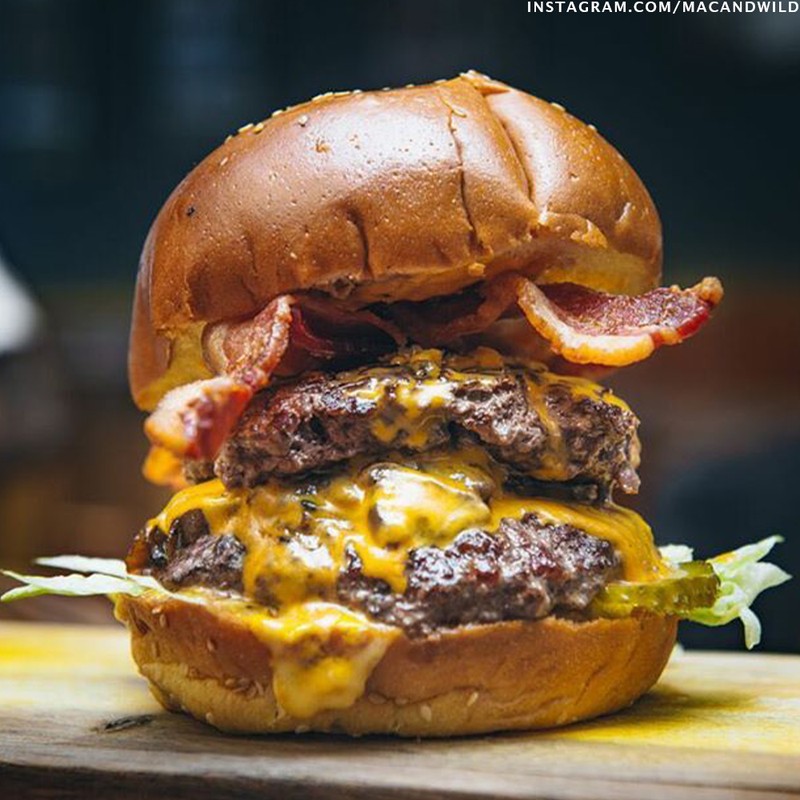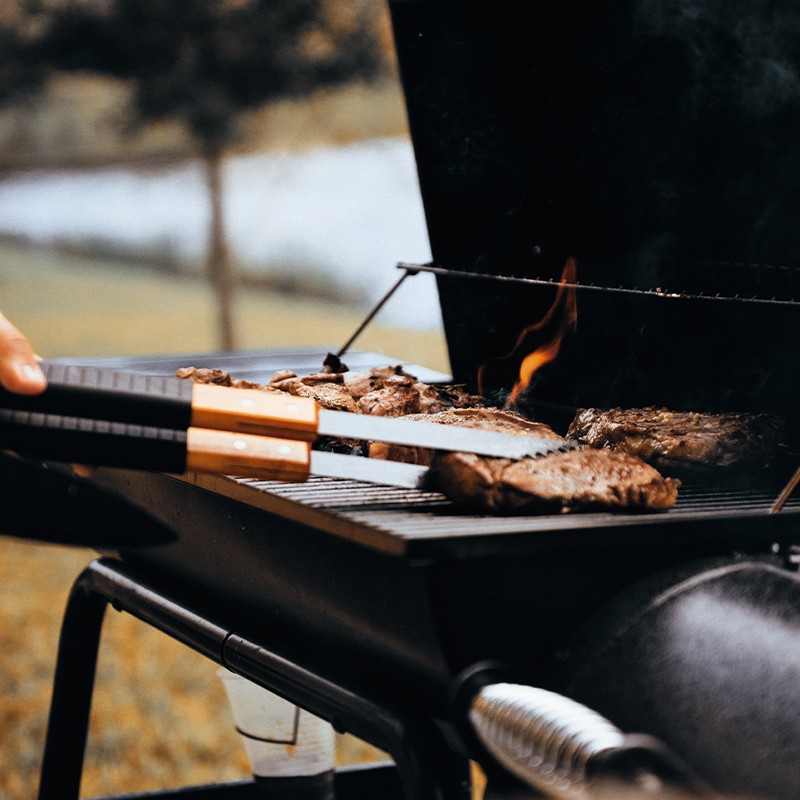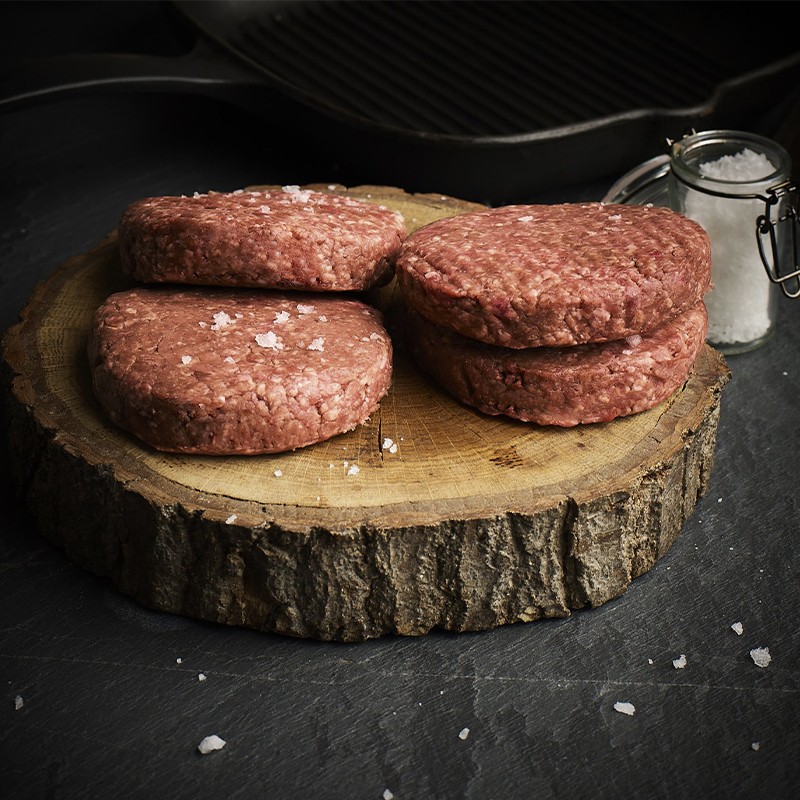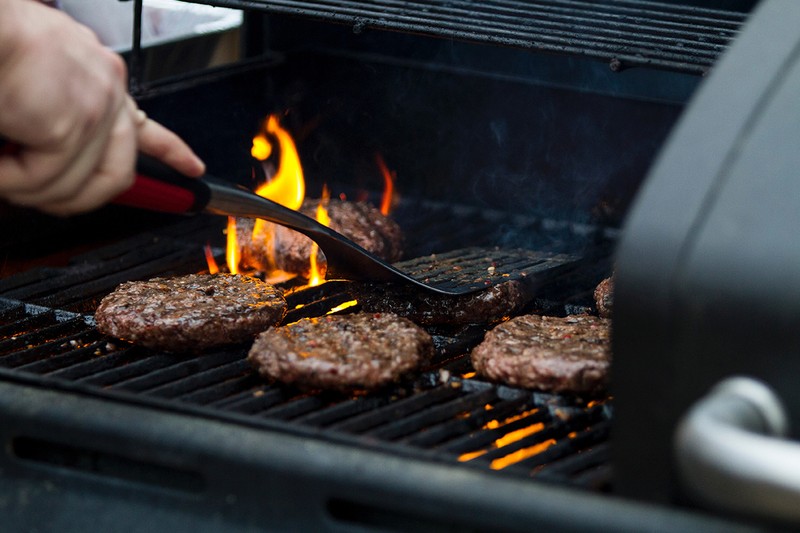18 Pro Tips For Homemade Burgers
THE MEAT
“When it comes to making the best burgers at home, make sure you’re using a good meat-to-fat ratio. We tend to go for 20-25% fat for a juicy texture and flavoursome patty. When testing we took it right up to 50%, which was pure indulgence but far too fatty for an everyday BBQ. In terms of the actual meat, we’re all about the selecting the right breed, pasture and husbandry of the cattle as a top priority. If the cow has had a happy life, you can taste it in the final product.” – Farshad Kazemian, The Ethical Butcher
“Tough, rubbery burgers are the worst. Chewing on tough meat is just about the opposite of what burgers are about. Get the best meat you can from your local butcher. Ask them to grind you a burger blend with a high fat content of 20-30%. If your butcher won’t do this for you, find another one.” – Rob Wade, Bite Me Burger
“I love a mix of beef, fat and marrow. I use aged beef and prefer to use cuts such as brisket, chuck or short rib which are packed full of flavour and generally have good intramuscular fat content and aged fat. This fat has been protecting my steak cuts as they age, and will have become nice and dry.” – Sophie Cumber, Butchery at Bowhouse
“Don't worry too much about different meats – once you've added all your sauces, cheese and pickles, you may as well be eating tofu. For me, it is what the meat stands for more than anything. If you use pasture fed/the closest-thing-to-nature-you-can-find, then I'll be singing on the inside long before I even clap eyes on the burger. My main piece of advice would be to consider the fat content and ageing of the meat. At Mac & Wild we use wild venison that has negligible fat, so we add caramelised onion and béarnaise to up the ante.” – Andy Waugh, Mac & Wild
“We use the whole animal at Blacklock and make something of everything. This is great for burgers as we use a mix of prime trimmings, brisket and the chuck for a good amount of meat, and with nice fat ratios. We also add 10% bone marrow and 10% aged beef fat for a deeper flavour.” – Gordon Ker, Blacklock
THE PATTIES
“With burgers, it’s important to take the time to mix all of the ingredients together really thoroughly. This will ensure the right texture when you come to cook and serve the patties. If the mix feels a little dry, add a couple of tablespoons of milk to the patty mixture to make them juicier. Always use a mix of fresh herbs, which will help to season your burgers and bring out the flavours of your meat. And be sure to remove your burger mix from the fridge at list 20 minutes before you start cooking.” – Ioannis Grammenos, Heliot Steak House
“Do not put salt in your minced meat. Salt starts to break down the proteins and makes the meat bind together tightly. This is one of the reasons processed patties are so rubbery. Wait until the burger hits the grill, then season away generously with salt and pepper. When shaping, a gentle caress is what’s called for. The more you handle the meat, the more it will bind. Just gently bring it together into a patty and leave it alone. Think about it this way: the way you make sausages is by kneading the meat and salt together. You don’t want your burger to have the texture of a banger. Finally, don’t make the patty too thin, or it’ll overcook before it’s had a chance to get good and charred. I’m not talking a 90s-style boulder in a bun, but about 2cm is good. If you haven’t overworked the mix, it won’t tighten up into a ball on the grill.” – Rob Wade, Bite Me Burger
“The mince we use has a 70:30 beef to fat ratio and we add absolutely nothing to it, all we do is knead the mince either with hands and a bowl or in a mixer with a paddle attachment, to get the fat and the proteins to soften and bind. We add no salt, no pepper, no herbs to the mix: if you’re using mince from a cow that was raised to high-welfare standards, that’s all the flavour you need. We also massively advocate 4oz patties over the 8, 10 or even 12oz alternatives – a thinner patty will naturally cook so much quicker, meaning you will avoid that dry, crumbly texture. Once they are worked and shaped, season the outside as you would a steak, just before cooking.” – James Santillo, The Duke’s Head
“The best way to shape the burgers is by hand, but before you do that it is very important to take your burger mix out of the fridge and leave at room temperature for 30 minutes. Following this, use your hands to mix the burger mince well to combine the fats with leaner meat. That helps to stop the burger sticking when it’s cooked on the BBQ. Using your hands, shape the mix to a ball shape and press with your hand to make a patty shape. The edges around the patty might not be perfect in thickness but no need to worry – when cooked, this brings another dimension to the burger flavour. Those crispy charred bits are delish.” – Gordon Ker, Blacklock
“I like to keep it simple when it comes to burgers and let the meat speak for itself, so I don’t add any seasonings or flavourings or – god forbid – egg or breadcrumbs. Most important is the addition of bone marrow, scooped out of the beef bones, which gives the burger a super meaty flavour, as well as an extra juicy texture.” – Sophie Cumber, Butchery at Bowhouse
THE COOKING
“Set your grill up for goof-proof cooking, leaving a ‘safe zone’ on the grill. The easiest way to set up your grill is the half and half technique by putting charcoal on one side and no charcoal on the other. By doing this, you can get a good charred colour on your food over the direct heat, but if the heat and flames are too intense, you can move your food to the more indirect side. This is also a great way to ensure your meat is cooked all the way through. To create deep, intense and flavourful grilled food, use seasoned fruit woods when grilling or smoking. The best woods to use are wild cherry, birch, orange, beech and sweet chestnut. Avoid elderflower or pine wood as they let off an acrid smoke, but most importantly use what’s local – there’s no need to import seasoned woods.” – DJ BBQ
“Whether you’re using a pan, BBQ, chargrill or whatever, you’ll be creating the most prominent flavours by colouring the outside of the patty. This is what allows the meat to sing and produces the bitter-sweet and umami flavours. So whichever heat source you’re using, get the power up high, and don’t mess with the burger too much during cooking – every time you move it, you’ll be losing heat. The meat will begin to set as it cooks, and this is your best guide to doneness. Think of it this way: if you pushed a finger into the raw patty, the indent would just stay there. Once it’s half cooked, it will gently spring back, and once it’s overcooked it will be completely firm to touch. You’re aiming for the point where it’s springy but not fully set. It takes a little practice, but you can always cut one in half to see how it’s getting on. Just pop the two halves in a bun and give it to your least favourite guest.” – Rob Wade, Bite Me Burger
“I like burgers cooked to medium on the charcoal grill. We sear ours on the plancha using vintage irons to get them nice and caramelised on the outside, but still pink and juicy in the middle. The good thing about adding bone marrow to the mix is it retains juiciness even if the guest prefers it cooked through.” – Gordon Ker, Blacklock
THE BUN
“The bun is a big component, and burger enthusiasts can get a bit tribal about the brioche bun versus burger bun debate. Which is a little silly, because there isn’t really a difference. A burger bun is just bread dough enriched with some sugar and fat (usually butter, milk and maybe a bit of egg), and guess what brioche is? The same thing. The real question is: do you want your bun to be closer to bread or cake in texture? I like a very traditional American-style burger bun – lightly enriched and just a tiny bit sweet. It’s very soft but definitely more like bread than cake. For me the super-soft buns just don’t do the job, they get soggy and fall apart and can tend to revert to dough – but it’s your burger not mine. Just decide what works for you.” – Rob Wade, Bite Me Burger
“Always use a great quality bun. A top tip: always use a cloche to steam the bun and melt the cheese. Simply add your cheese and bun to the burger in the pan, add some water to the pan and cover with a cloche for 15-30 seconds before serving.” – Andy Waugh, Mac & Wild
THE TOPPINGS
“For me, toppings are the least structured part of the burger. You can let your imagination run wild, or just chuck in a bit of ketchup and mayo. Remember, burgers eat best when they can be held in one hand, with a drink in the other. If you need a knife and fork or a bib, it’s probably just going to become a chore to eat it. Side salads go on the side. I love a touch of crisp fresh lettuce or onion in a burger, but three parts salad to one part meat just makes for a really sad afternoon. And don’t forget the pickles – burgers are fatty and buns are sweet, so you need some acidity for balance. If you don’t like pickles you can use a few fine slices of raw onion. It really helps balance the whole thing.” – Rob Wade, Bite Me Burger
“A real game changer of a burger topping is a slice of black pudding. I like to cut quite a thin slice and get it really crispy before adding it to my burger.” – Sophie Cumber, Butchery at Bowhouse
“Our popular Blacklist Burger is filled with double patties and double cheese with hot dog-style onions, a few pickled gherkins and our take on burger sauce – delicious and messy, just how we like burgers. That said, a classic cheeseburger with beef tomato is hard to beat!” – Gordon Ker, Blacklock
DISCLAIMER: We endeavour to always credit the correct original source of every image we use. If you think a credit may be incorrect, please contact us at [email protected].







